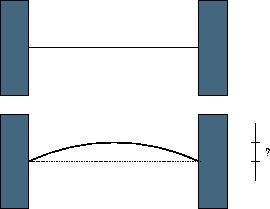Expanding Rods
| Time Limit: 1000MS | Memory Limit: 30000K | |
| Total Submissions: 12160 | Accepted: 3160 |
Description
 When a thin rod of length L is heated n degrees, it expands to a new length
When a thin rod of length L is heated n degrees, it expands to a new length
L'=(1+n*C)*L, where C is the coefficient of heat expansion.
When a thin rod is mounted on two solid walls and then heated, it expands and takes the shape of a circular segment, the original rod being the chord of the segment.
Your task is to compute the distance by which the center of the rod is displaced.
Your task is to compute the distance by which the center of the rod is displaced.
Input
The input contains multiple lines. Each line of input contains three non-negative numbers: the initial lenth of the rod in millimeters, the temperature change in degrees and the coefficient of heat expansion of the material. Input data guarantee that no rod expands by more than one half of its original length. The last line of input contains three negative numbers and it should not be processed.
Output
For each line of input, output one line with the displacement of the center of the rod in millimeters with 3 digits of precision.
Sample Input
1000 100 0.0001 15000 10 0.00006 10 0 0.001 -1 -1 -1
Sample Output
61.329 225.020 0.000, where C is the coefficient of heat expansion.
When a thin rod is mounted on two solid walls and then heated, it expands and takes the shape of a circular segment, the original rod being the chord of the segment.
Your task is to compute the distance by which the center of the rod is displaced.
Input
The input contains multiple lines. Each line of input contains three non-negative numbers: the initial lenth of the rod in millimeters, the temperature change in degrees and the coefficient of heat expansion of the material. Input data guarantee that no rod expands by more than one half of its original length. The last line of input contains three negative numbers and it should not be processed.
Output
For each line of input, output one line with the displacement of the center of the rod in millimeters with 3 digits of precision.
Sample Input
1000 100 0.0001 15000 10 0.00006 10 0 0.001 -1 -1 -1
Sample Output
61.329 225.020 0.000
题目大意:有已知长度的一根木棒,随着温度变化有伸缩变化,根据公式L'=(1+n*C)*L得到新的木棍长度,在两面墙之间会弯曲,求木棍前后状态的中点之间的距离。
解题思路:联系相关几何知识得到公式:L'=2*r*arcsin(L/(2*r),r=(4*h*h+L*L)/(8*h)。采用二分枚举h的值得到r的值,然后公式1作为判断条件,直接求出h的值。
解题过程:wa点:注意浮点型的二分结束循环的条件是(high-low>minx),这题minx精度尽量大一些才能过。
代码如下:
#include <cstdio>
#include <cmath>
const double minx=1e-8;
int main()
{
double l,n,c,L,high,low,mid,r;
while(scanf("%lf%lf%lf",&l,&n,&c)!=EOF&&(l>=0||n>=0||c>=0))
{
L=(1+n*c)*l;
high=l/2;
low=0.0;
while(high-low>minx)
{
mid=(high+low)/2;
r=(4*mid*mid+l*l)/(8*mid);
if(2*r*asin(l/(2*r))<L)
low=mid;
else
high=mid;
}
printf("%.3f\n",mid);
}
return 0;
}





















 427
427











 被折叠的 条评论
为什么被折叠?
被折叠的 条评论
为什么被折叠?








